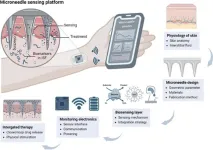(Press-News.org) La version française suit
Opioid use disorder: updated clinical practice guideline
An updated evidence-based guideline aimed at helping clinicians and other health care providers manage patients with opioid use disorder recommends buprenorphine and methadone as first-line treatments. The guideline is published in CMAJ (Canadian Medical Association Journal). https://www.cmaj.ca/lookup/doi/10.1503/cmaj.241173
Opioid use and opioid use disorder are the leading causes of drug-related deaths worldwide, and Canada has seen a 184% increase is opioid-related deaths over 7 years from 2831 deaths in 2016 to 8049 deaths in 2023. Treatment options have improved with the removal of methadone prescribing restrictions in 2018 in Canada, but opioid-related harms continue to rise.
“Opioid use disorder and opioid related harms have devastating outcomes for our communities across Canada and with the growing dangers associated with the illicit market, we need to ensure we are sharing the most relevant therapeutic tools and up-to-date knowledge to help providers and communities address this complex issue,” says Dr. Ginette Poulin, a family physician, University of Manitoba, Winnipeg, Manitoba.
The guideline, an update to the 2018 national guideline for the clinical management of opioid use disorder from the Canadian Research Initiative in Substance Matters, focuses on oral treatments and includes special considerations for pregnant people. Injectable opioid agonist therapy, extended-release agonists, and antagonists are beyond the scope of this guideline.
“The management of opioid use disorder is a rapidly changing and ever-evolving landscape of new research and clinical considerations,” says lead author Dr. Igor Yakovenko, associate professor, Department of Psychology and Neuroscience and Department of Psychiatry, Dalhousie University, Halifax, Nova Scotia. “This guideline provides an important update to health practitioners on the latest science in the field so that Canadian providers can continue to maintain a high standard of evidence-based care.”
The recommendations, based on new research since the previous guideline was published, include the key change that opioid agonist treatment with buprenorphine–naloxone is no longer the sole first-line treatment and methadone is now also recommended as a first-line option.
The update is aimed at physicians, nurse practitioners, pharmacists, clinical psychologists, social workers, medical educators, clinical care case managers with or without specialized experience in addiction treatment, and other allied health care professionals who provide care for people with opioid use disorder.
Key recommendations:
Buprenorphine (also refers to buprenorphine–naloxone) and methadone can be used as standard first-line treatment options for opioid agonist therapy
Slow-release oral morphine can be used as second-line treatment
Avoid withdrawal management as stand-alone treatment and ensure long-term management to ensure safety and well-being of people with opioid use disorder
Psychosocial treatments and supports, such as therapy, should be offered as additional approaches but should not be mandatory nor prevent access to opioid agonist therapy
Pregnant people can be offered buprenorphine or methadone as treatment options
The authors hope that the guideline will provide evidence-based treatment for opioid users and recommend that provinces update their approaches to managing opioid use disorder to help Canadians.
“Too many people die from untreated opioid addiction in Canada,” says Dr. Peter Selby, Centre for Addiction and Mental Health and the University of Toronto. “We have medicines that help people stop using but too few are treated due to stigma and lack of prescribers knowing what to do. These national guidelines help them use proven medications to not only prevent death but actually help people recover.”
Find the full guideline, with an easy-to-use table of recommendations and an infographic here.
“Management of opioid use disorder: 2024 update to the national clinical practice guideline” is published November 12, 2024.
Troubles liés à l'utilisation d'opioïdes : mise à jour du guide de pratique clinique
Une mise à jour de la ligne directrice fondée sur des données probantes visant à aider les cliniciens et autres prestataires de soins de santé à prendre en charge les patients atteints de troubles liés à l'utilisation d'opioïdes recommande notamment d’utiliser la buprénorphine et la méthadone comme traitement de première ligne. Cette ligne directrice sera publiée dans le JAMC (Journal de l'Association médicale canadienne) (disponsible en anglais seulement. La ligne directrice est en cours de traduction en français et sera publiée ultérieurement).
Les troubles liés à l'usage d'opioïdes comptent parmi les principales causes de décès liés aux drogues dans le monde. Au Canada, les décès liés aux opioïdes ont augmenté de 184 % en sept ans, passant de 2831 en 2016 à 8049 en 2023. Les options de traitement se sont améliorées avec la suppression des restrictions de prescription de la méthadone en 2018 au Canada, mais les dommages liés aux opioïdes continuent d'augmenter.
« Avec les dangers croissants associés au marché illicite, nous devons nous assurer que nous partageons les outils thérapeutiques les plus pertinents et les connaissances les plus récentes pour aider les prestataires de soins et les communautés à faire face à ce problème complexe », déclare le Dre Ginette Poulin, médecin de famille à l'Université du Manitoba, Winnipeg.
Le guide, qui est une mise à jour du guide national de 2018 pour la prise en charge clinique des troubles liés à l'utilisation d'opioïdes de l'Initiative canadienne de recherche sur les substances (ICRAS), se concentre sur les traitements oraux et inclut des considérations particulières pour les femmes enceintes. Les traitements par agonistes opioïdes injectables, agonistes et antagonistes à libération prolongée dépassent le cadre de ces lignes directrices.
« La prise en charge des troubles liés à l'utilisation d'opioïdes est un domaine en évolution rapide et constante, marqué par de nouvelles recherches et considérations cliniques », déclare l'auteur principal, le Dr Igor Yakovenko, professeur associé au département de psychologie et de neurosciences et au département de psychiatrie de l'Université Dalhousie, à Halifax, en Nouvelle-Écosse. « Ces lignes directrices constituent une mise à jour importante pour les praticiens de la santé sur les dernières données scientifiques dans ce domaine, afin que les prestataires canadiens puissent continuer à maintenir un niveau élevé de soins fondés sur des données probantes ».
Les recommandations, basées sur les nouvelles recherches effectuées depuis la publication de la précédente ligne directrice, comprennent un changement clé : le traitement par agoniste opioïde avec buprénorphine–naloxone n'est plus le seul traitement de première ligne et la méthadone est désormais également recommandée comme option de première ligne.
Cette mise à jour s'adresse aux médecins, aux infirmières praticiennes, aux pharmaciens, aux psychologues cliniciens, aux travailleurs sociaux, aux éducateurs médicaux, aux gestionnaires de cas de soins cliniques avec ou sans expérience spécialisée dans le traitement des addictions, et aux autres professionnels de santé alliés qui fournissent des soins aux personnes souffrant d'un trouble lié à l'utilisation d'opioïdes.
Principales recommandations :
La buprénorphine (également appelée buprénorphine–naloxone) et la méthadone peuvent être utilisées comme options thérapeutiques standard de première intention pour le traitement par agonistes opioïdes.
La morphine orale à libération lente peut être utilisée comme traitement de deuxième intention.
Éviter la gestion du sevrage en tant que traitement autonome et assurer une gestion à long terme pour garantir la sécurité et le bien-être des personnes souffrant de troubles liés à l'utilisation d'opioïdes.
Les traitements et soutiens psychosociaux, tels que la thérapie, doivent être proposés en tant qu'approches supplémentaires, mais ne doivent pas être obligatoires ni empêcher l'accès au traitement par agonistes opioïdes.
Les femmes enceintes peuvent se voir proposer la buprénorphine ou la méthadone comme options de traitement.
Les auteurs espèrent que cette ligne directrice permettra d'offrir un traitement fondé sur des données probantes aux consommateurs d'opioïdes et recommande aux provinces d'actualiser leurs approches de la gestion du trouble lié à l'utilisation d'opioïdes afin d'aider les Canadiens.
« Trop de personnes meurent d'une dépendance aux opioïdes non traitée au Canada », déclare le Dr Peter Selby, du Centre de toxicomanie et de santé mentale (CAMH) et de l'Université de Toronto. Nous disposons de médicaments qui aident les gens à arrêter de consommer, mais trop peu d'entre eux sont traités en raison de la stigmatisation et du fait que les prescripteurs ne savent pas ce qu'il faut faire. Cette ligne directrice nationale les aide à utiliser des médicaments éprouvés non seulement pour prévenir la mort, mais aussi pour aider les gens à se rétablir ».
Le guide complet, avec un tableau des recommandations facile à utiliser et une infographie, est disponible ici (disponsible en anglais seulement. La ligne directrice est en cours de traduction en français et sera publiée ultérieurement).
END
Opioid use disorder: Updated clinical practice guideline
2024-11-12
ELSE PRESS RELEASES FROM THIS DATE:
Microneedle sensors for dermal interstitial fluid analysis
2024-11-12
The rapid advancement in personalized healthcare has driven the development of wearable biomedical devices for real-time biomarker monitoring and diagnosis. Traditional invasive blood-based diagnostics are painful and limited to sporadic health snapshots. To address these limitations, microneedle-based sensing platforms have emerged, utilizing interstitial fluid (ISF) as an alternative biofluid for continuous health monitoring in a minimally invasive and painless manner.
The team led by Wei Gao from California Institute of Technology providea a comprehensive overview of microneedle sensor technology, covering microneedle design, fabrication methods, ...
‘Sleepy cannabis’: first study to show cannabinol increases sleep
2024-11-12
Research by scientists at the University of Sydney has identified a constituent in the cannabis plant that improves sleep.
Their report is the first to use objective measures to show the component, known as cannabinol (CBN), increases sleep in rats.
The study has been published in the leading journal Neuropsychopharmacology.
“For decades, cannabis folklore has suggested that aged cannabis makes consumers sleepy via the build-up of CBN, however there was no convincing evidence for this,” said lead author on the study Professor Jonathon Arnold, ...
Mount Sinai team shows AI can detect serious neurologic changes in babies in the NICU using video data alone
2024-11-12
A team of clinicians, scientists, and engineers at Mount Sinai trained a deep learning pose-recognition algorithm on video feeds of infants in the neonatal intensive care unit (NICU) to accurately track their movements and identify key neurologic metrics.
Findings from this new artificial intelligence (AI)-based tool, published November 11 in Lancet’s eClinicalMedicine, could lead to a minimally invasive, scalable method for continuous neurologic monitoring in NICUs, providing critical real-time insights into infant health that have not been possible before.
Every year, more than 300,000 ...
Jeffrey Popma, MD, joins CRF as Chief Scientific and Strategic Officer
2024-11-11
NEW YORK – November 11, 2024 – The Cardiovascular Research Foundation® (CRF®) proudly announces the appointment of Dr. Jeffrey Popma as Chief Scientific and Strategic Officer. A world-renowned leader in cardiovascular research, Dr. Popma will drive forward pivotal programs and initiatives that will shape CRF’s future and fuel innovation at the CRF® Clinical Trials Center (CTC). His leadership will be instrumental in the development of the recently launched Real-World Data and Outcomes Center, advancing CRF’s commitment to impactful ...
Seiber elevated to IEEE senior member
2024-11-11
Larry Seiber, an R&D staff member in the Vehicle Power Electronics group at the Department of Energy’s Oak Ridge National Laboratory, has been elevated to senior member of the Institute of Electrical and Electronics Engineers, or IEEE.
Senior member status requires extensive experience that reflects professional accomplishments. Only 10% of IEEE’s more than 450,000 members achieve this level.
Seiber has conducted decades of cutting-edge research in power electronics and electric machinery. He developed the hardware ...
Study sheds light on how BRCA1 gene mutations fuel breast cancer
2024-11-11
People inherit two copies of each gene — one from each parent — an evolutionary fail-safe to ensure survival even when one of them doesn’t function.
For cancer-suppressor genes like BRCA1, researchers have long hypothesized that a single healthy copy could still guard against tumor development. Yet women with one harmful BRCA1 mutation are far more likely to develop breast cancer — a risk traditionally explained by a second mutation that arises later in life, damages the healthy copy of the gene, ...
A new wrinkle in turtles: Their genomes fold in a unique way, Iowa State researchers find
2024-11-11
AMES, Iowa – In their long strings of nucleotides, DNA molecules hold massive troves of genetic data providing instructions for how living organisms should function – the blueprint of life. How the blueprint is stored, however, impacts how it is read and used.
As cells divide and replicate, DNA strands coiled around proteins – chromatin – are in tightly bundled chromosomes. After division, the chromosomes loosen and chromatin is less compact. How and where the chromatin fiber folds and ...
Adequate sleep significantly reduces the risk of hypertension in adolescents, according to new study
2024-11-11
Adolescents who meet the recommended guidelines of nine to 11 hours of sleep per day were shown to have a significantly lower risk of hypertension, according to a new study from UTHealth Houston.
Recently published in the Journal of the American Heart Association, the research revealed that adolescents had a 37% lower risk of developing incidents of high blood pressure by meeting healthy sleep patterns, and underscoring the importance of adequate sleep behavior. The research further explored the ...
Research spotlight: Uncovering the mechanisms behind T cell differentiation
2024-11-11
How would you summarize your study for a lay audience?
T helper (TH) cells are essential immune cells that help other immune cells function effectively. When activated in response to environmental stimuli, these cells can differentiate into either TH1 cells, which fight against viruses and intracellular pathogens, or TH2 cells, which fight against extracellular pathogens like bacteria and parasites. However, scientists haven’t fully understood whether infected tissue itself has any role in directing the optimal T cell differentiation in response ...
Study reveals best timing for getting the RSV vaccine during pregnancy to protect newborns
2024-11-11
Current guidelines recommend that pregnant people receive a vaccine against respiratory syncytial virus (RSV)—which typically causes mild, cold-like symptoms in most adults but can be deadly for infants—during weeks 32–36 of pregnancy. New research led by investigators at Mass General Brigham suggests that vaccination earlier in that timeframe, closer to 32 weeks, could provide the best protection for newborns against RSV. The findings are published in the American Journal of Obstetrics & Gynecology.
“Receiving ...



